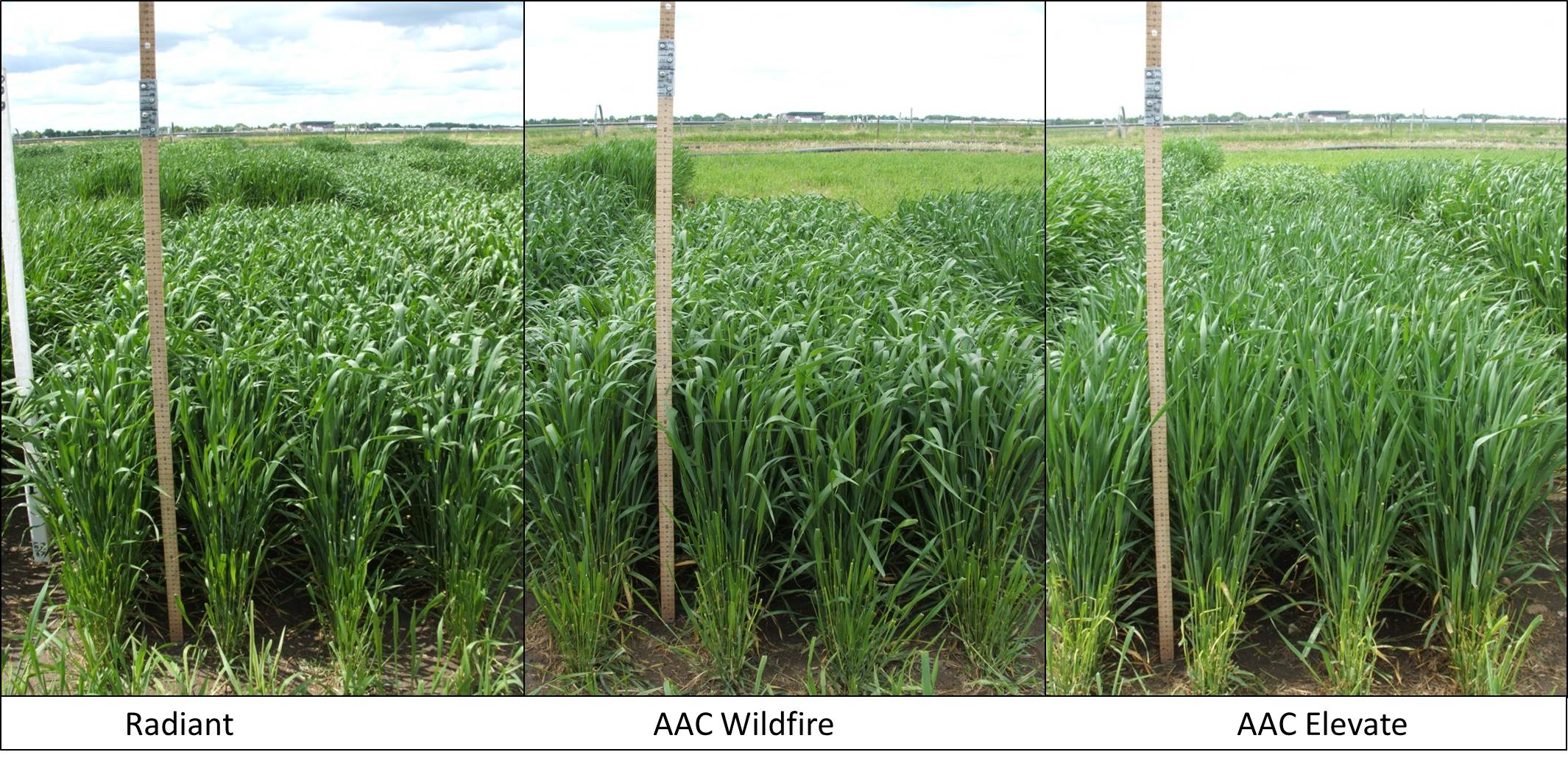AAC Wildfire
| Denomination: | 'AAC Wildfire' |
|---|---|
| Botanical Name: | Triticum aestivum |
| Applicant/Holder: |
Agriculture & Agri-Food Canada, Lethbridge Lethbridge Research Centre, 5403 - 1 Avenue, South P.O. Box 3000 Lethbridge, Alberta T1J 4B1 Canada |
| Breeder: |
Robert Graf, Agriculture & Agri-Food Canada, Lethbridge, Alberta |
| Agent in Canada: |
Agriculture & Agri-Food Canada Office of Intellectual Property and Commercialization c/o Shannon Whyte 107 Science Place Saskatoon, Saskatchewan S7N 0X2 Canada Tel: (204) 999-9887 |
| Application Date: | 2015-11-04 |
| Provisional Protection:: | 2015-11-04 |
| Application Number: | 15-8742 |
| Grant of Rights Date: | 2018-08-16 |
| Certificate Number: | 5794 |
| Grant of Rights Termination Date: | 2038-08-16 |
Variety Description
Varieties used for comparison: 'AAC Elevate' and 'Radiant'
Summary: At booting, the frequency of plants with recurved flag leaves is very high for 'AAC Wildfire' whereas the frequency is very low for 'AAC Elevate' and high for 'Radiant'. 'AAC Wildfire' has a longer flag leaf than that of the reference varieties. The upper culm of 'AAC Wildfire' has absent to very weak glaucosity whereas the upper culm of 'AAC Elevate' has medium glaucosity and that of 'Radiant' has medium to strong glaucosity. At maturity, the spike attitude of 'AAC Wildfire' is inclined whereas it is inclined to nodding for 'AAC Elevate' and erect for 'Radiant'. At maturity, the spike of 'AAC Wildfire' is reddish-brown, and shorter than the spike of 'AAC Elevate', which is white to yellow.
Description:
PLANT: hard red winter type, intermediate to semi-prostrate growth habit at the 5 to 9 tiller stage, very high frequency of plants with recurved flag leaves, medium tillering capacity at low densities, matures mid-season
SEEDLING (4 LEAF STAGE): medium green, absent or very weak intensity of anthocyanin colouration of coleoptile, prostrate growth habit, glabrous sheath and blade of lower leaves
FLAG LEAF: medium to dark green, medium length and width, strongly to very strongly recurved, upright attitude, glabrous blade and sheath, medium glaucosity of blade, medium to strong glaucosity of sheath
AURICLES: absent or very weak intensity of anthocyanin colouration, weak to medium density of pubescence of margin
CULM NECK: glabrous uppermost internode, absent or very weak glaucosity, straight
STRAW (AT MATURITY): very thin pith in cross-section, weak anthocyanin colouration, yellow
SPIKE: weak to medium glaucosity at heading, tapering shape in profile, medium density, medium length, reddish-brown at maturity, inclined attitude, rachis margin strongly pubescent, no supernumerary spikelets
AWNS: length equal to spike length, light brown, slight to moderately spreading attitude
GLUME: light brown to brown at maturity
LOWER GLUME: medium to long, medium width, glabrous, no internal imprint
LOWER GLUME SHOULDER: narrow width, straight
LOWER GLUME BEAK: medium length, moderately curved
KERNEL: medium red, medium to large, medium to hard
AGRONOMIC CHARACTERISTICS: good to very good resistance to shattering and lodging, good to very good winter survival
BREAD MAKING QUALITY: fair
DISEASE REACTIONS: resistant to Stripe rust (Puccinia striiformis), moderately resistant to Fusarium head blight (Fusarium species) and Common bunt (Tilletia caries, Tilletia foetida), moderately resistant to moderately susceptible to Leaf rust (Puccinia recondita), highly susceptible to Stem rust (Puccinia graminis f. sp. tritici)
INSECT REACTION: resistant to Russian wheat aphid (Biotype 1)
Origin & Breeding History: 'AAC Wildfire' (experimental designations 'W512' and 'LK1064') originated from the cross 'L99-1236' and 'AC Bellatrix' made in 2003 at the Agriculture and Agri-Food Canada Lethbridge Research and Development Centre, Lethbridge, Alberta. In 2005, several F2 bulk plots were grown in Lethbridge, from which 78 spikes were selected and planted as F3 rows. In 2006, 84 spikes were selected based on winter survival, plant type, vigour, height, straw strength and stripe rust resistance. These spikes were grown in an inoculated common bunt nursery from which 76 spikes were selected from 43 rows that showed low infection. These 76 spikes were seeded into observation rows in Lethbridge. In 2008, 30 desirable F4-derived F5 lines were harvested and seeded in single replicate preliminary trials and in an inoculated bunt nursery. Replicated trials at multiple locations were conducted across western Canada in 2010 and 2011. The line designated as 'LK1064' was entered into the Western Winter Wheat Cooperative Registration trial as 'W512' and was evaluated for three years from 2011 to 2014.
Tests & Trials: The comparative tests and trials for 'AAC Wildfire' were conducted at the Agriculture and Agri-Food Research and Development Centre, Lethbridge, Alberta during the 2014 and 2015 growing seasons. Each trial had 4 replicates arranged in a RCB design. Each replicate consisted of 4 rows with a row length of 3.5 metres, a row spacing of 23 cm and a planting density of approximately 350 plants per square metre. Measured characteristics were based on a minimum of 60 measurements per variety per year. Mean differences were significant at the 5% probability level based on LSD values.
Comparison tables for 'AAC Wildfire' with reference varieties 'AAC Elevate' and 'Radiant'
Flag leaf length (cm)
| 'AAC Wildfire' | 'AAC Elevate' | 'Radiant' | |
|---|---|---|---|
| mean 2014 (LSD=1.0) | 24.3 | 21.7 | 22.5 |
| std. deviation 2014 | 3.0 | 2.4 | 2.9 |
| mean 2015 (LSD=1.4) | 33.8 | 28.1 | 25.4 |
| std. deviation 2015 | 4.0 | 3.9 | 3.8 |
Spike length (excluding awns) (mm)
| 'AAC Wildfire' | 'AAC Elevate' | 'Radiant' | |
|---|---|---|---|
| mean 2014 (LSD=2.8) | 86.4 | 90.7 | 90.0 |
| std. deviation 2014 | 7.0 | 7.4 | 8.5 |
| mean 2015 (LSD=2.3) | 107.2 | 118.4 | 109.2 |
| std. deviation 2015 | 6.2 | 6.3 | 7.0 |
Click on image for larger view

Wheat: 'AAC Wildfire' (centre) with reference varieties 'Radiant' (left) and 'AAC Elevate' (right)
Click on image for larger view

Wheat: 'AAC Wildfire' (centre) with reference varieties 'Radiant' (left) and 'AAC Elevate' (right)
- Date modified: